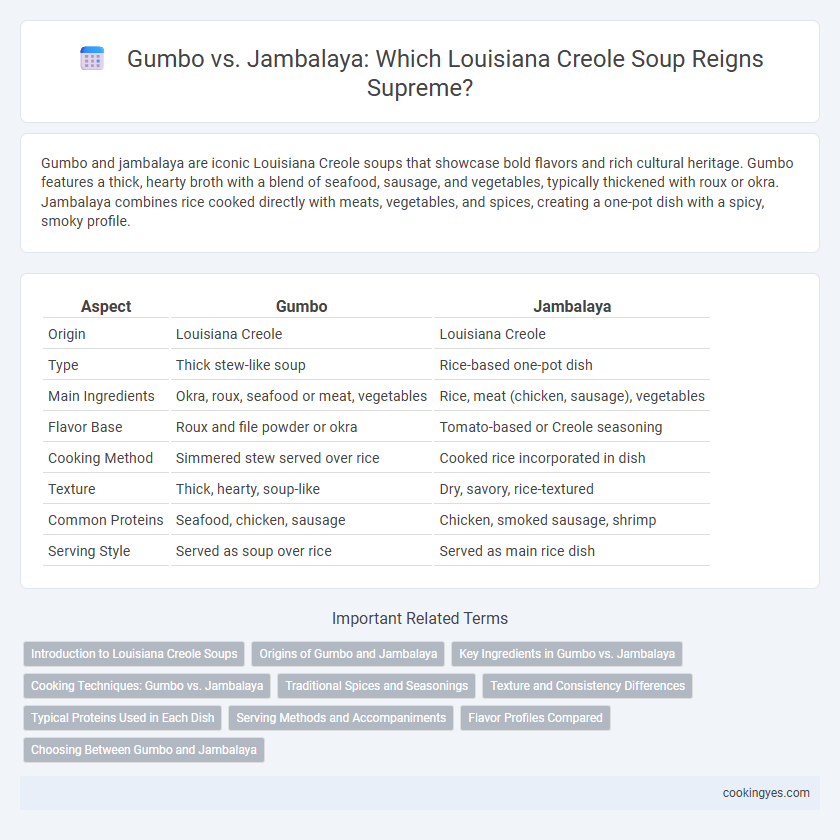Gumbo and jambalaya are iconic Louisiana Creole soups that showcase bold flavors and rich cultural heritage. Gumbo features a thick, hearty broth with a blend of seafood, sausage, and vegetables, typically thickened with roux or okra. Jambalaya combines rice cooked directly with meats, vegetables, and spices, creating a one-pot dish with a spicy, smoky profile.
Table of Comparison
| Aspect | Gumbo | Jambalaya |
|---|---|---|
| Origin | Louisiana Creole | Louisiana Creole |
| Type | Thick stew-like soup | Rice-based one-pot dish |
| Main Ingredients | Okra, roux, seafood or meat, vegetables | Rice, meat (chicken, sausage), vegetables |
| Flavor Base | Roux and file powder or okra | Tomato-based or Creole seasoning |
| Cooking Method | Simmered stew served over rice | Cooked rice incorporated in dish |
| Texture | Thick, hearty, soup-like | Dry, savory, rice-textured |
| Common Proteins | Seafood, chicken, sausage | Chicken, smoked sausage, shrimp |
| Serving Style | Served as soup over rice | Served as main rice dish |
Introduction to Louisiana Creole Soups
Louisiana Creole soups showcase a rich blend of French, African, Spanish, and Caribbean influences, with gumbo and jambalaya standing out as iconic dishes. Gumbo features a thick, flavorful broth often enriched with roux, okra, and a variety of meats or seafood, while jambalaya is a hearty rice-based dish cooked with spices, vegetables, and proteins. Both soups exemplify the complex seasoning and vibrant culinary heritage that define Louisiana Creole cuisine.
Origins of Gumbo and Jambalaya
Gumbo originated in Louisiana as a rich, hearty stew influenced by French, African, and Native American culinary traditions, often featuring okra or file powder as a key thickening agent. Jambalaya, on the other hand, evolved from Spanish paella, blending Creole and Cajun flavors with rice, meat, and vegetables cooked in one pot. Both dishes represent the diverse cultural heritage of Louisiana Creole cuisine but differ significantly in preparation and texture.
Key Ingredients in Gumbo vs. Jambalaya
Gumbo features a rich, dark roux base combined with the "holy trinity" of Creole cooking: onions, bell peppers, and celery, often including okra and file powder for thickening. Jambalaya incorporates rice cooked directly with proteins like chicken, sausage, and shrimp, alongside tomatoes and the holy trinity, creating a hearty, one-pot dish. While gumbo relies on a thickened broth and served over rice, jambalaya's key ingredient is the rice cooked into the dish itself, blending flavors throughout.
Cooking Techniques: Gumbo vs. Jambalaya
Gumbo relies on simmering a rich, dark roux combined with a blend of holy trinity vegetables and okra or file powder, creating a thick, stew-like consistency. Jambalaya involves sauteing proteins and vegetables before adding rice and broth, allowing the dish to absorb flavors as the rice cooks, resulting in a drier, more textured meal. The key difference lies in gumbo's slow, prolonged simmering for depth versus jambalaya's one-pot cooking that integrates rice directly into the flavor base.
Traditional Spices and Seasonings
Gumbo and jambalaya each showcase distinctive traditional spices and seasonings central to Louisiana Creole cuisine, with gumbo typically featuring a robust blend of file powder, bay leaves, thyme, and cayenne pepper to create its signature deep, smoky flavor. Jambalaya relies heavily on a bold combination of smoked paprika, thyme, oregano, and the "holy trinity" of onions, celery, and bell peppers to deliver its vibrant, spicy taste. Both dishes emphasize the importance of seasoning balance, but gumbo's use of thickening agents like roux and file powder sets its flavor and texture apart from the rice-based jambalaya.
Texture and Consistency Differences
Gumbo features a thick, stew-like consistency achieved through a dark roux base, giving it a rich and velvety texture that coats the ingredients. Jambalaya, on the other hand, has a drier, rice-based consistency where the grains absorb the flavorful broth, resulting in a more granular and hearty mouthfeel. The contrast in texture highlights gumbo's soupy, spoonable nature versus jambalaya's casserole-like density.
Typical Proteins Used in Each Dish
Gumbo typically features proteins such as andouille sausage, chicken, and shellfish like crawfish, crab, or shrimp, creating a rich, hearty broth representative of Louisiana Creole cuisine. Jambalaya, by contrast, often includes a combination of smoked sausage, chicken, and seafood, cooked with rice for a textured blend of flavors. Both dishes highlight local proteins but differ in preparation and presentation, reflecting unique cultural influences.
Serving Methods and Accompaniments
Gumbo is traditionally served as a thick, hearty stew over white rice, enhancing its rich, roux-based flavors with a spoonful of starch. Jambalaya combines rice and meat in a singular simmered dish, often presented without separate accompaniments, emphasizing its one-pot convenience. Both dishes embrace Creole seasoning but differ distinctly in serving style: Gumbo offers a bowl with rice as a base, while Jambalaya integrates rice directly into the meal.
Flavor Profiles Compared
Gumbo features a rich, roux-based broth infused with the deep flavors of okra, file powder, and smoked sausage, delivering a hearty and complex taste. Jambalaya combines seasoned rice with a medley of meats like chicken, sausage, and seafood, absorbing bold Creole spices that create a vibrant, spiced flavor profile. The distinct difference lies in gumbo's soup consistency and thickened texture versus jambalaya's drier, rice-centered dish with robust, layered seasonings.
Choosing Between Gumbo and Jambalaya
Gumbo features a rich, flavorful broth thickened with roux and often contains a mix of seafood, sausage, and vegetables, making it ideal for those seeking a hearty soup experience. Jambalaya offers a one-pot blend of rice, meats such as chicken or sausage, and spices, delivering a more solid, stew-like consistency with bold Creole seasoning. Selecting between gumbo and jambalaya depends on whether you prefer a soupy dish with complex textures or a rice-based, filling meal with vibrant spices.
Gumbo vs Jambalaya for Louisiana Creole soups Infographic

 cookingyes.com
cookingyes.com